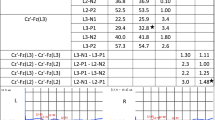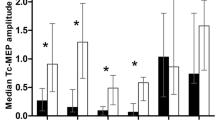Abstract
Purpose
We aimed to investigate the value of intraoperative multi-channel recording of somatosensory evoked potentials (SSEPs) in patients undergoing posterior instrumentation surgery with fusion.
Methods
This study included 176 patients with scoliosis who underwent posterior correction surgery from January 2019 to June 2020. Among them, 88 patients underwent routine SSEPs monitoring via single-channel (Cz'-Fpz) cortical recording (control group), while the remaining 88 patients underwent multi-channel (Cz'-Fpz and C3'-C4') SSEPs monitoring in the cortex. Chi-square and Fisher’s exact tests were used to analyze the influence of age, spinal deformity classification, and Cobb angle on waveform differentiation and the success rate of SSEPs monitoring.
Results
Univariate analysis revealed that age, type of scoliosis, and Cobb angle exerted significant effects on the success rate of intraoperative SSEPs monitoring, and the SSEPs waveform differentiation rate was poorest among patients with congenital scoliosis. Intraoperative monitoring results indicated that the success rate of single-channel SSEPs monitoring was 90.9%, while that of multi-channel monitoring was 98.9% (P < 0.05). Among the intraoperative alarm cases, the incidence of adverse events after single-channel SSEPs monitoring was 66.7%, while the incidence of adverse events after multi-channel SSEPs monitoring was only 28.6%.
Conclusion
Multi-channel cortical SSEPs monitoring can effectively and accurately evaluate the function of the posterior column of the spinal cord. Use of multi-channel SSEP monitoring may help to improve the success rate of monitoring and reduce the incidence of postoperative adverse events in patients with congenital scoliosis.


Similar content being viewed by others
References
DiCindio S, Theroux M, Shah S, Miller F, Dabney K, Brislin RP, Schwartz D (2003) Multimodality monitoring of transcranial electric motor and somatosensory-evoked potentials during surgical correction of spinal deformity in patients with cerebral palsy and other neuromuscular disorders. Spine (Phila Pa 1976) 28(16):1851–1855 (discussion 1855-1856)
Nuwer MR, MacDonald DB, Gertsch J (2022) Monitoring scoliosis and other spinal deformity surgeries. Handb Clin Neurol 186:179–204
Brodsky MA, Anderson S, Murchison C, Seier M, Wilhelm J, Vederman A, Burchiel KJ (2017) Clinical outcomes of asleep vs awake deep brain stimulation for Parkinson disease. Neurology 89(19):1944–1950
Helbok R, Schiefecker AJ, Beer R, Dietmann A, Antunes AP, Sohm F, Fischer M, Hackl WO, Rhomberg P, Lackner P et al (2015) Early brain injury after aneurysmal subarachnoid hemorrhage: a multimodal neuromonitoring study. Crit Care 19:75
Legatt AD, Emerson RG, Epstein CM, MacDonald DB, Deletis V, Bravo RJ, Lopez JR (2016) ACNS guideline: transcranial electrical stimulation motor evoked potential monitoring. J Clin Neurophysiol 33(1):42–50
Mooij JJ, Mustafa MK, van Weerden TW (2001) Hemifacial spasm: intraoperative electromyographic monitoring as a guide for microvascular decompression. Neurosurgery 49(6):1365–1370 (discussion 1370-1361)
Sasaki T, Itakura T, Suzuki K, Kasuya H, Munakata R, Muramatsu H, Ichikawa T, Sato T, Endo Y, Sakuma J et al (2010) Intraoperative monitoring of visual evoked potential: introduction of a clinically useful method. J Neurosurg 112(2):273–284
Nuwer MR, Cohen BH, Shepard KM (2013) Practice patterns for intraoperative neurophysiologic monitoring. Neurology 80(12):1156–1160
Qiu J, Li Y, Liu W, Zhu Z, Shi B, Liu Z, Sun X, Qiu Y (2021) Intra-operative neurophysiological monitoring in patients with dystrophic neurofibromatosis type 1 scoliosis. Somatosens Mot Res 38(2):95–100
Nuwer MR, Dawson EG, Carlson LG, Kanim LE, Sherman JE (1995) Somatosensory evoked potential spinal cord monitoring reduces neurologic deficits after scoliosis surgery: results of a large multicenter survey. Electroencephalogr Clin Neurophysiol 96(1):6–11
Renehan JR, Ye IB, Thomson AE, Pease TJ, Smith RA, Fencel R, Oster B, Cavanaugh D, Koh EY, Gelb DE et al (2022) Intraoperative sensory signals predict prognosis for patients with traumatic cervical spinal cord injury. World Neurosurg. https://doi.org/10.1016/j.wneu.2022.10.056
Seyal M, Emerson RG, Pedley TA (1983) Spinal and early scalp-recorded components of the somatosensory evoked potential following stimulation of the posterior tibial nerve. Electroencephalogr Clin Neurophysiol 55(3):320–330
Strahm C, Min K, Boos N, Ruetsch Y, Curt A (2003) Reliability of perioperative SSEP recordings in spine surgery. Spinal Cord 41(9):483–489
Owen JH, Naito M, Bridwell KH, Oakley DM (1990) Relationship between duration of spinal cord ischemia and postoperative neurologic deficits in animals. Spine (Phila Pa 1976) 15(9):846–851
Agarwal N, Shabani S, Huang J, Ben-Natan AR, Mummaneni PV (2022) Intraoperative monitoring for spinal surgery. Neurol Clin 40(2):269–281
Pastorelli F, Di Silvestre M, Plasmati R, Michelucci R, Greggi T, Morigi A, Bacchin MR, Bonarelli S, Cioni A, Vommaro F et al (2011) The prevention of neural complications in the surgical treatment of scoliosis: the role of the neurophysiological intraoperative monitoring. Eur Spine J 20(Suppl 1):S105-114
Shi B, Qiu J, Xu L, Li Y, Jiang D, Xia S, Liu Z, Sun X, Shi B, Zhu Z et al (2020) Somatosensory and motor evoked potentials during correction surgery of scoliosis in neurologically asymptomatic chiari malformation-associated scoliosis: a comparison with idiopathic scoliosis. Clin Neurol Neurosurg 191:105689
Sebel Ps (1988) Evoked Potential Monitoring in the Operating Room, 1st Edn. By Nuwer M. Published by Raven Press, New York, Pp. 246; indexed; illustrated. BJA: British Journal of Anaesthesia 60:123
Jou IM (2000) Effects of core body temperature on changes in spinal somatosensory-evoked potential in acute spinal cord compression injury: an experimental study in the rat. Spine (Phila Pa 1976) 25(15):1878–1885
Thirumala PD, Bodily L, Tint D, Ward WT, Deeney VF, Crammond DJ, Habeych ME, Balzer JR (2014) Somatosensory-evoked potential monitoring during instrumented scoliosis corrective procedures: validity revisited. Spine J 14(8):1572–1580
Chau WW, Chu WC, Lam TP, Ng BK, Fu LL, Cheng JC (2016) Anatomical origin of abnormal somatosensory-evoked potential (SEP) in adolescent idiopathic scoliosis with different curve severity and correlation with cerebellar tonsillar level determined by MRI. Spine (Phila Pa 1976) 41(10):E598-604
Sarwark JF, Dabney KW, Salzman SK, Wakabayashi T, Kitadai HK, Beauchamp JT, Beckman AL, Bunnell WP (1988) Experimental scoliosis in the rat. I. Methodology, anatomic features and neurologic characterization. Spine (Phila Pa 1976) 13(5):466–471
Pincott JR, Taffs LF (1982) Experimental scoliosis in primates: a neurological cause. J Bone Joint Surg Br 64(4):503–507
Chen Z, Qiu Y, Ma W, Qian B, Zhu Z (2014) Comparison of somatosensory evoked potentials between adolescent idiopathic scoliosis and congenital scoliosis without neural axis abnormalities. Spine J 14(7):1095–1098
Chen X, Sterio D, Ming X, Para DD, Butusova M, Tong T, Beric A (2007) Success rate of motor evoked potentials for intraoperative neurophysiologic monitoring: effects of age, lesion location, and preoperative neurologic deficits. J Clin Neurophysiol 24(3):281–285
Gonzalez AA, Droker BS, Kim ES, Parikh P (2022) Success rate of obtaining baseline somatosensory and motor evoked potentials in 695 consecutive cranial and spine surgeries. J Clin Neurophysiol 39(6):513–518
Acknowledgements
This work was funded by grants provided by the: National Natural Science Foundation of China (82260181), Key project of Natural Science Basic Research Plan of Shaanxi Province (2022JZ-43).
Author information
Authors and Affiliations
Corresponding authors
Ethics declarations
Conflict of interest
The authors declare that they have no known competing financial interests or personal relationships that could have appeared to influence the work reported in this paper.
Ethical approval
This study was approved by the Ethics Committee of the Affiliated Honghui Hospital of Xi 'an Jiaotong University, No.202212006.
Additional information
Publisher's Note
Springer Nature remains neutral with regard to jurisdictional claims in published maps and institutional affiliations.
Rights and permissions
Springer Nature or its licensor (e.g. a society or other partner) holds exclusive rights to this article under a publishing agreement with the author(s) or other rightsholder(s); author self-archiving of the accepted manuscript version of this article is solely governed by the terms of such publishing agreement and applicable law.
About this article
Cite this article
Yuan, Y., Zhang, Y., Song, X. et al. Value of multi-channel somatosensory evoked potentials recording in patients undergoing scoliosis correction surgery. Eur Spine J 32, 4045–4053 (2023). https://doi.org/10.1007/s00586-023-07899-8
Received:
Revised:
Accepted:
Published:
Issue Date:
DOI: https://doi.org/10.1007/s00586-023-07899-8




